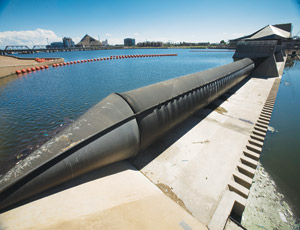An inflatable dam in downtown Tempe, Ariz., burst on July 20, emptying most of the contents of the 1-billion-gal Tempe Town Lake. No one was injured and no property was damaged in the resulting flood, which traveled down the normally dry Salt River through Phoenix. Peak flows were measured at 15,000 cu ft per second, equivalent to an average release during the area’s winter rainy season.

The two-mile lake was formed in 1999 using eight flexible, rubber-coated fabric tubes manufactured by Tokyo-based Bridgestone Industrial Products Group. A rip in the seam near the top of one of the four downstream bladders caused the failure. Each segment is 240 ft long and weighs up to 40 tons.
The bladders had outlived their original 10-year warranty, although city officials say they were led to believe the dam segments would last more than 30 years. The intense desert heat and ultraviolet radiation prematurely weakened the structures, which should have been maintained with a watering system, as Bridgestone specified.
“When the dams were originally installed, they were designed to have a watering system that would allow [for a] continuous flow of water over the dams,” says Tempe Mayor Hugh Hallman. “That did not occur.”
Furthermore, at the time, Bridgestone’s manufacturing process included ceramic chips for added strength, but the desert’s hot-cool cycle exacerbated the deterioration, he adds.
Bridgestone has manufactured and installed approximately 200 such dams in North America, with no other failures reported, says Don Darden, the company’s executive director of communications. However, none of the other dams are in such harsh environments.
In 2008, Bridgestone announced it would no longer manufacture inflatable dams and entered an agreement with the city of Tempe to replace the downstream dam segments at Bridgestone’s cost.
Ironically, work was scheduled to begin to replace the bladders the morning after the dam burst.
The Tempe office of PCL Civil Constructors is the general contractor on the $3-million replacement project, which had been delayed several months by unusually wet weather in the region.
The dam failure may work to the city’s advantage. With the lake already empty, crews will not need to build cofferdams around each segment in order to replace them, says Charlie Meyer, city manager. With the expectation that three of the bladders can be replaced while the lake is empty and one bladder can be replaced as the lake refills, work is expected to take just 90 days instead of one year.
The replacement segments are intended as a five-year stopgap measure until the city chooses a permanent solution, Darden says. Since the reservoir is located inside an existing riverbed, the dams must be deflatable to allow seasonal floodwaters to pass through the system.


Post a comment to this article
Report Abusive Comment